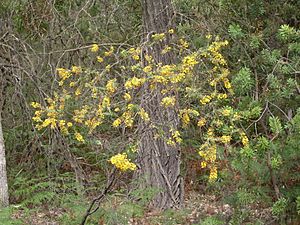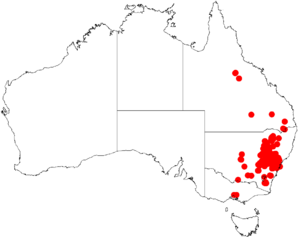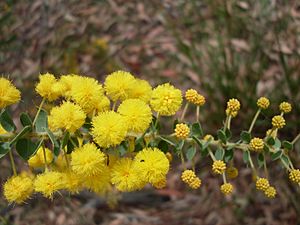Gold-dust wattle facts for kids
Quick facts for kids Gold-dust wattle |
|
|---|---|
 |
|
| Acacia uncinata habit | |
| Scientific classification | |
| Genus: |
Acacia
|
| Species: |
uncinata
|
 |
|
| Occurrence data from AVH | |
The Gold-dust wattle (scientific name: Acacia uncinata) is a cool shrub that belongs to the Acacia plant family. It's also sometimes called the round-leaved wattle because of its unique leaves. You can find this plant growing naturally in parts of eastern Australia.
What Does the Gold-Dust Wattle Look Like?
This wattle plant usually grows like a bush, reaching about 1.5 to 2.5 meters (that's about 5 to 8 feet) tall. Its leaves aren't typical leaves; they are actually flattened leaf stems called phyllodes. These phyllodes are a dull grey-green color and can be flat or slightly twisted. They are shaped like an oval or a wider oval, measuring about 17 to 45 millimeters long and 10 to 23 millimeters wide.
The Gold-dust wattle blooms between September and November. During this time, it produces up to 20 flower clusters. Each cluster is a round ball of 14 to 23 pale yellow flowers. After the flowers fade, firm, leathery brown seed pods grow. These pods are flat or slightly curved and are about 3 to 7 centimeters long and 12 to 21 millimeters wide.
How It Got Its Name
The Gold-dust wattle was first officially described by a botanist named John Lindley in 1830. He wrote about it in a publication called Edwards's Botanical Register.
Later, in 1987, another botanist named Leslie Pedley gave it a different scientific name, Racosperma uncinatum. But in 2006, it was moved back to the Acacia group. The second part of its scientific name, uncinata, means "hooked" or "barbed." This refers to the slightly curved tip of its phyllodes.
This plant looks a lot like another wattle called Acacia aureocrinita. It also has a few other old names, or synonyms, including Acacia oleifolia, Acacia dysophylla, Acacia undulifolia var. dysophylla, and Acacia undulifolia.
Where Does It Grow?
The Gold-dust wattle is found in the northeastern part of Mount Kaputar National Park in New South Wales, Australia. It likes to grow along watercourses and on hillsides. You'll often see it in areas where Eucalyptus and Callitris trees grow, especially in rocky, sandy-loam soils.


